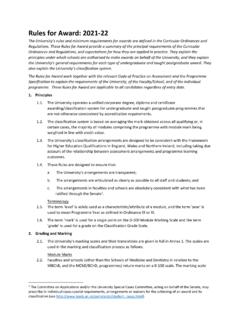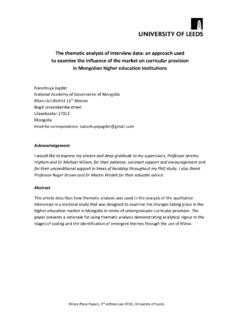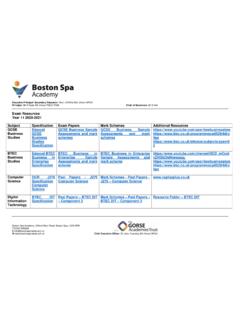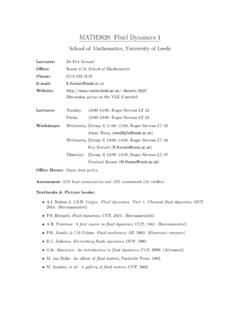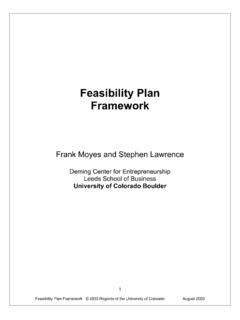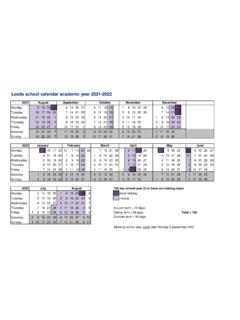Transcription of Introduction to Structural Geology - University of Leeds
1 ContentsSchool of Earth and EnvironmentIntroduction to Structural GeologyWorkbook 2 StereonetsContentsSchool of Earth and Environment2 ContentsIntroduction to stereonets 4 Stereonet terminology 6 Setting up a stereonet 71. Plotting a plane 82. Plotting a lineation 113. Plotting a pole 154. Pi-plots and folds on stereonets 175. Restorations 236. Reading measurements from a stereonet 27 Practical exercises 29 Acknowledgements and references 43 ContentsSchool of Earth and Environment3 How to use this workbookThis worksheet aims to be a general Introduction to stereonets that covers basic plotting and some of the more common uses of stereonets in Structural Geology .
2 By the end of this workbook and associated exercises you should understand what a stereonet is, why they are used in structure Geology and be confident in plotting, manipulating and interpreting data on a worksheet includes basic plotting exercises. Those already confident with plotting data on stereonets may wish to skip these and concentrate on the self-assessment exercises at the end of the workbook. Answers to the plotting exercises can be found by clicking on a reading. The correct answer is shown together with common plotting errors. The stereonet used for the exercises is an equal area stereonet. A blank stereonet is included on a seperate PDF. ContentsSchool of Earth and Environment4 Introduction to stereonetsA stereonet is a lower hemisphere graph on to which a variety of geological data can be plotted.
3 Stereonets are used in many different branches of Geology and can be used in a range of ways beyond those which are discussed here (see references for further uses). Stereographic projection involves plotting 3D data (planar or linear) on to a 2D surface (stereonet) where it can be manipulated and interpreted. Imagine a sphere with lines of latitude and longitude marked on it. A stereonet is the plane of projection of the lower half of this sphere it is a lower hemisphere graph. Imagine a plane cutting through the centre of a lower hemisphere (figure 1a). The stereonet forms the surface of this lower hemisphere. Looking from above, where the plane touches the edge of the lower hemisphere is an arc. This arc is projected back up on to the stereonet to form a great circle (figure 1b).
4 Figure 1c shows the resulting plot. Figure 1bFigure 1cFigure 1aProjection planestereonetProjection planestereonetProjection sphereGreat circle of dipping plane onstereonetSpherical projection of dipping planeStereographic projection of dipping planeSpherical projection of dipping planeDipping planeContentsSchool of Earth and Environment5 Figure 2 shows this for a lineation. The lineation lies on the plane (figure 2a), where it touches the edge of the lower hemisphere is a point. This point is projected back up on to the stereonet as a point (figure 2b). Figure 2c shows the resulting plot. Notice how the lineation plots on the great circle of the plane. Planes ( bedding, cleavage, faults etc.) plot as great circles, and lineations ( slickensides, bedding/cleavage lineations, fold axes etc.)
5 Plot as this workbook, all stereonets will be plotted by hand using card stereonets and tracing paper. Why use card stereonets, with tracing paper and drawing pins when data could be input straight into a computer program or a smart phone app? The obvious reason is one needs to understand the theory behind stereonets to be able to usefully interpret them and to recognise an aberration in the output, which may be due to an input/measurement error. This is best done learning to plot by hand. In the field, for those using notebooks, it is useful to be able to draw a sketch stereonet to test a theory on the geometry of a structure being mapped. Finally, working with stereonets also helps develops 3D thinking, an essential skill in Structural 2aFigure 2bFigure 2cProjection sphereProjection planestereonetProjection planestereonetStereographic projection of lineationGreat circle of dipping plane onstereonetPlot of lineationIntersection of lineation with projection sphereContentsSchool of Earth and Environment6 Stereonet terminologyFigure 3 shows the terminology used to describe the different parts of a stereonet.
6 As a stereonet is a lower hemisphere it is described in a similar way to a globe with north and south poles and an equator across the middle. Great circles are longitudinal, whilst small circles are latitudinal. The primitive is the outside of the stereonet. The stereonet grid is divided into two degree segments with a thicker ten degree lines (figure 4). Strikes and azimuths (bearings) are read around the primitive of the stereonet, dips and plunges are read along the equator. 000 050 020 010 090 060 080 070 040 030 180 270 50 20 10 90 60 80 70 40 30 50 20 10 60 80 70 40 30 Small circleEquatorNorth poleSouth poleGreat circlePrimitiveEquatorFigure 3: Equal Area Stereonet (Schmidt): each of the sectors has the same 4: Equal Area Stereonet showing the degrees around the primitive and across the of Earth and Environment7 Setting up a stereonetMake a hole in the exact centre of the stereonet, by pushing the drawing pin through from the front of the stereonet.
7 Then remove the drawing pin and push it through the hole from the back. Lay the tracing paper over the stereonet and push the drawing pin through it so that the paper freely rotates round the net Draw the outline of the stereonet on to the tracing paper. Mark on north, south, east, west or 000 , 090 , 180 , 270 (figure 5). Click below to watch our YouTube video: How to set up a stereonetNorthEastSouthWestOutline of stereonet on tracing paperDrawing pinTracing paperFigure 5: How to set up a stereonetContentsSchool of Earth and Environment8 Worksheet 1: Plotting a planePlanes are measured using strike/dip and dip direction (figure 6) (other methods of measuring are used but this is the convention followed at Leeds and so in the videos, exercises etc).
8 Examples of planes are bedding, faults, cleavage, fold axial planes : the line of the horizontal on a plane. Measured from north in degrees and recorded as three figures eg. 057 Dip: The maximum dip of a plane. Measured in degrees from the horizontal and recorded as two figures eg. 34. Perpendicular to the strike Also need dip direction to fully describe the plane eg 057/34 SEStrikeDipFigure 6: Bedding planes dipping towards the road (Miller, 2012).ContentsSchool of Earth and Environment9 How to plot a plane Strike/dip 090/40S Mark on the strike - 090 Note which way the plane is dipping, then rotate the tracing paper round until this mark is aligned with north on the stereonet. Find the great circle of the plane by counting in the angle of dip along the equator from the primitive.
9 Count in from the direction of dip as marked on the tracing paper (in this case S). Mark with a dot. Using a sharp pencil or colour pencil, draw in the great circle from the north pole through point to the south pole. Rotate the tracing paper back to north. Check the plane is dipping in the correct direction and admire your work. 000 180 270 090 000 090 270 180 000 090 180 270 000 180 270 090 ContentsSchool of Earth and Environment10 Exercise: Plotting planes on a stereonetPlot the following planes on a stereonet 032/20NW 102/65S 177/33E 065/82 NWClick on the readings to see the answers000 180 270 090 Click below to watch our YouTube video: How to plot a plane?ContentsSchool of Earth and Environment11 Worksheet 2: Plotting a lineationLineations are measured using plunge/ azimuth.
10 Examples of lineations are slickensides and slickenfibres on a fault surface (figure 7), fold axes, mineral stretching lineation or ripple : The dip of a lineation as measured from the horizontal. It is measured between 0-90 and always recorded as two figures. Azimuth: Azimuth is the direction of plunge. It is a bearing and so measured between 0-360 and recorded as three figures. a lineation plunging at 45 towards 270 would be written: 45/270 PlungeAzimuthFigure 8: Steeply plunging slickenfibres on a fault plane ( ).Figure 9: Gently plunging bedding-cleavage lineation ( ) See page 7: Plunge and azimuth of a of Earth and Environment12 How to plot a lineation Plunge and azimuth: 25/225 Mark on the azimuth reading 225 Rotate the tracing paper round until this mark is aligned with equator on the stereonet.



